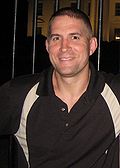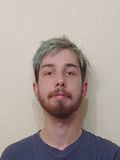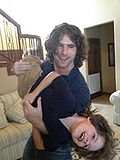Difference between revisions of "People"
(→Dr. Robert Schweller) |
(→Andrew Alseth) |
||
| (76 intermediate revisions by 9 users not shown) | |||
| Line 1: | Line 1: | ||
| − | == | + | ==Site Administrators (The Algorithmic Self-Assembly and Natural Computing Group at the University of Arkansas)== |
===Dr. Matthew Patitz=== | ===Dr. Matthew Patitz=== | ||
[[File:Matt-DC_web.jpg|120px|border|left]] | [[File:Matt-DC_web.jpg|120px|border|left]] | ||
| − | Matt is an assistant professor of [http:// | + | Matt is an assistant professor of [http://csce.uark.edu Computer Science and Computer Engineering] at the [http://www.uark.edu/home University of Arkansas]. He graduated with his PhD in [http://www.cs.iastate.edu Computer Science] from [http://www.iastate.edu Iowa State University] in May 2010, and was an assistant professor of [http://portal.utpa.edu/utpa_main/daa_home/coecs_home/cs_home Computer Science] at the [http://www.utpa.edu/ University of Texas-Pan American] from the fall of 2010 through the spring of 2012. |
Matt's research interests focus mainly on self-assembling and self-organizing systems which display complexity arising from simple components and local interactions. There are many examples in the natural world of both living and non-living systems in which large numbers of small, autonomous pieces form systems that are extremely complex without any centralized control and from simple sets of rules. By studying existing systems and designing novel ones, he hopes to help illuminate fundamental properties of such systems which give rise to their complex behavior, including life. Additionally, the creation of complex artificial systems which self-assemble and self-organize could help to revolutionize many areas of technology. | Matt's research interests focus mainly on self-assembling and self-organizing systems which display complexity arising from simple components and local interactions. There are many examples in the natural world of both living and non-living systems in which large numbers of small, autonomous pieces form systems that are extremely complex without any centralized control and from simple sets of rules. By studying existing systems and designing novel ones, he hopes to help illuminate fundamental properties of such systems which give rise to their complex behavior, including life. Additionally, the creation of complex artificial systems which self-assemble and self-organize could help to revolutionize many areas of technology. | ||
| Line 13: | Line 13: | ||
---- | ---- | ||
| + | <br> | ||
| + | |||
| + | |||
| + | ===Daniel Hader=== | ||
| + | [[File:Daniel_hader_picture.jpg|120px|border|left]] | ||
| + | |||
| + | Daniel is a research assistant to Dr. Matthew Patitz and a Doctoral Academy Fellow. He started his PhD program in fall 2018 in the Department of Computer Science and Computer Engineering at the University of Arkansas. | ||
| + | |||
| + | Daniel is interested in models of algorithmic self-assembly. Particularly, he is interested in comparing these models and their relative computational power. By changing the rules of these models, even slightly, major differences in dynamics can occur. Investigating these differences can lead to beautiful hierarchies and deep insights into how different restrictions can affect computational systems. | ||
| + | |||
| + | ---- | ||
| + | Page: [http://self-assembly.net/dhader/ Homepage] | ||
| + | ---- | ||
| + | |||
| + | <br> | ||
| + | <br> | ||
| + | ===Andrew Alseth=== | ||
| − | === | + | Andy is a graduate research assistant to Dr. Matthew Patitz and a PhD student in the Computer Science and Computer Engineering department at the University of Arkansas. He joined the group in January of 2021 after completing a MS in Industrial Engineering at the University of Arkansas. |
| − | + | ||
| + | Andy's current research pertains to algorithmic tile assembly (with an emphasis on signal tiles), and is broadly interested in studying the computational properties of natural systems. | ||
| + | |||
| + | <br> | ||
| + | <br> | ||
| + | |||
| + | ==Alumni== | ||
| + | |||
| + | |||
| + | ===Michael Sharp=== | ||
| + | Michael was a MS student in Computer Science working with Matt Patitz's group. His research focused on algorithmic self-assembly of systems capable of folding and reconfiguring. He graduated in 2019. | ||
| + | <br> | ||
| + | <br> | ||
| + | ===Dr. Trent Rogers=== | ||
| + | [[File:Trent.jpeg|120px|border|left]] | ||
| − | + | Trent was a National Science Foundation Graduate Research Fellow and the recipient of the Doctoral Academy Fellowship. In fall 2014, he started the PhD program in computer science at the University of Arkansas with Matt Patitz's group and graduated in 2019. | |
| − | + | Trent's research has been focused on algorithmic self-assembly and he is currently a postdoc with Dr. Damien Woods' group at Maynooth University (web page here: https://dna.hamilton.ie/). Through self-assembling systems, we are able to appreciate and better understand the elegance and simplicity that nature uses to create the complex and chaotic natural world around us. Studying self-assembling systems does not only gives us a glimpse into the intricacies of our world, but also allows us the ability to create innovative technologies. | |
---- | ---- | ||
| − | + | (Previous Home page: [http://self-assembly.net/trogers/ Homepage]) | |
| + | ---- | ||
| + | <br> | ||
| + | <br> | ||
| + | |||
| + | ===Jacob Hendricks=== | ||
| + | Jacob was a PhD student in Computer Science at the University of Arkansas who graduated in 2015. (See his entry below) | ||
| + | <br> | ||
| + | ===Tyler Fochtman=== | ||
| + | Tyler was a Masters student in Computer Science at the University of Arkansas who graduated in May of 2017 | ||
---- | ---- | ||
| + | Page: [http://self-assembly.net/tfochtman/ Homepage] | ||
| + | ---- | ||
| + | |||
| + | <br> | ||
| + | <br> | ||
| + | |||
| + | ==Contributors== | ||
| − | === | + | ===Dr. Jacob Hendricks=== |
<br> | <br> | ||
| − | + | Jacob is an assistant professor of Computer Science at the University of Wisconsin--River Falls. He graduated with his PhD in Computer Science from the University of Arkansas in May 2015, and was a Post-doctoral Research Associate in the Bio/Nano Technology Group at the University of Arkansas in summer 2015. | |
| + | |||
| + | Jacob's interests are two-fold. First, he is interested in the theoretical modeling of nanoparticles with the goal of understanding systems in which simple local interactions lead to complex global behaviors and/or structures. Studying such systems may not only contribute to a better understanding of complexities that arise in nature but also aid in the development of nanotechnologies. Secondly, he is interested in the computational modeling of nanoparticles. With the help of his collaborators, he is working to develop software capable of simulating the molecular dynamics of DNA-functionalized nanoparticle building blocks. | ||
| + | ---- | ||
| + | Page: [http://self-assembly.net/jhendricks/ Homepage] | ||
---- | ---- | ||
| − | + | <br> | |
| + | ===Dr. Scott Summers=== | ||
| + | |||
| + | <br> | ||
| + | |||
| + | Scott is an assistant professor of Computer Science at the University of Wisconsin--Oshkosh. Scott received his BS in Computer Science from the [http://www.uwgb.edu/compsci/ University of Wisconsin--Green Bay] in 2004 and an MS and PhD in Computer Science from [http://www.cs.iastate.edu Iowa State University] in 2007 and 2010, respectively. Scott was previously an assistant professor of Computer Science at the [http://www.uwplatt.edu/ University of Wisconsin--Platteville] in the [http://www.uwplatt.edu/csse/ department of Computer Science and Software Engineering] from 2010 to 2013. | ||
| + | |||
| + | Scott's currently interested in researching theoretical Computer Science, in general, and the theory of tile self-assembly, specifically. | ||
| + | |||
| + | ---- | ||
| + | Page: [http://self-assembly.net/ssummers/ Homepage] | ||
| + | ---- | ||
| + | |||
| + | <br> | ||
| + | <br> | ||
| + | |||
| + | ==Past Contributors== | ||
| + | |||
| + | ===Dr. Robert Schweller=== | ||
| + | [[File:kidThrow.jpg|120px|border|left]] | ||
| + | |||
| + | Robbie is an associate professor of [http://www.cs.panam.edu Computer Science] at the [http://www.utpa.edu University of Texas-Pan American]. Robbie received his Ph.D. in [http://www.cs.northwestern.edu Computer Science] from [http://www.northwestern.edu Northwestern University] in June 2007 and his B.A. in [http://apps.carleton.edu/curricular/math Mathematics] from [http://www.carleton.edu Carleton College] in June 2001. | ||
| + | |||
| + | Robbie's general research area is the design and analysis of algorithms. More specific interests include the algorithmic self-assembly of DNA, tile self-assembly, algorithmic nanotechnology, combinatorial code word design, graph labeling, anomaly/intrusion detection over network data streams, and bioinformatics. | ||
| + | |||
| + | ---- | ||
| + | Page: [https://faculty.utrgv.edu/robert.schweller/ Homepage] | ||
---- | ---- | ||
| + | <br> | ||
| + | <br> | ||
| + | <br> | ||
===Xingsi Zhong (Winston Zhong)=== | ===Xingsi Zhong (Winston Zhong)=== | ||
<br> | <br> | ||
| − | Xingsi | + | Xingsi was a graduate student in Department of Computer Science,UTPA. |
| − | + | ---- | |
| + | Page: [http://xszhong.com/ Homepage] | ||
---- | ---- | ||
| − | + | <br> | |
| + | |||
| + | ===Kagan DuPuy-Reagan=== | ||
| + | Kagan is an undergraduate student at the University of Arkansas pursuing a B.S. in Mathematics, with a Pure Math concentration. His interests are varied. At the moment, he is working on algorithmic self-assembly. | ||
| − | ---- | + | <br> |
| + | <br> | ||
| + | |||
| + | ==Other research groups== | ||
| + | Following are just a few of the research groups doing work related to self-assembly. If you'd like to have your group added, please email mpatitz@self-assembly.net. | ||
| + | |||
| + | ===TAPDANCE at Inria=== | ||
| + | Damien Woods' [https://tapdance.inria.fr/ TAPDANCE (Theory and Practice of DNA Computing Engines)] group at Inria, Paris | ||
| + | |||
| + | ===Doty's group at UC Davis=== | ||
| + | [http://web.cs.ucdavis.edu/~doty/ David Doty's] research group at UC Davis | ||
| + | |||
| + | ===DNA and Natural Algorithms group at Caltech=== | ||
| + | Erik Winfree's [http://www.dna.caltech.edu DNA and Natural Algorithms] group at Caltech | ||
| + | |||
| + | ===Reif's group at Duke=== | ||
| + | [http://www.cs.duke.edu/~reif John Reif's] research group at Duke University | ||
| + | |||
| + | ===Seeman's lab at NYU=== | ||
| + | [http://seemanlab4.chem.nyu.edu Ned Seeman's laboratory] at New York University | ||
| + | |||
| + | ===The ISU Laboratory for Algorithmic Nanoscale Self-Assembly=== | ||
| + | Jack Lutz's [http://www.cs.iastate.edu/~lnsa ISU Laboratory for Algorithmic Nanoscale Self-Assembly] at Iowa State University | ||
Latest revision as of 19:31, 27 June 2021
Contents
Site Administrators (The Algorithmic Self-Assembly and Natural Computing Group at the University of Arkansas)
Dr. Matthew Patitz
Matt is an assistant professor of Computer Science and Computer Engineering at the University of Arkansas. He graduated with his PhD in Computer Science from Iowa State University in May 2010, and was an assistant professor of Computer Science at the University of Texas-Pan American from the fall of 2010 through the spring of 2012.
Matt's research interests focus mainly on self-assembling and self-organizing systems which display complexity arising from simple components and local interactions. There are many examples in the natural world of both living and non-living systems in which large numbers of small, autonomous pieces form systems that are extremely complex without any centralized control and from simple sets of rules. By studying existing systems and designing novel ones, he hopes to help illuminate fundamental properties of such systems which give rise to their complex behavior, including life. Additionally, the creation of complex artificial systems which self-assemble and self-organize could help to revolutionize many areas of technology.
Page: Homepage
Daniel Hader
Daniel is a research assistant to Dr. Matthew Patitz and a Doctoral Academy Fellow. He started his PhD program in fall 2018 in the Department of Computer Science and Computer Engineering at the University of Arkansas.
Daniel is interested in models of algorithmic self-assembly. Particularly, he is interested in comparing these models and their relative computational power. By changing the rules of these models, even slightly, major differences in dynamics can occur. Investigating these differences can lead to beautiful hierarchies and deep insights into how different restrictions can affect computational systems.
Page: Homepage
Andrew Alseth
Andy is a graduate research assistant to Dr. Matthew Patitz and a PhD student in the Computer Science and Computer Engineering department at the University of Arkansas. He joined the group in January of 2021 after completing a MS in Industrial Engineering at the University of Arkansas.
Andy's current research pertains to algorithmic tile assembly (with an emphasis on signal tiles), and is broadly interested in studying the computational properties of natural systems.
Alumni
Michael Sharp
Michael was a MS student in Computer Science working with Matt Patitz's group. His research focused on algorithmic self-assembly of systems capable of folding and reconfiguring. He graduated in 2019.
Dr. Trent Rogers
Trent was a National Science Foundation Graduate Research Fellow and the recipient of the Doctoral Academy Fellowship. In fall 2014, he started the PhD program in computer science at the University of Arkansas with Matt Patitz's group and graduated in 2019.
Trent's research has been focused on algorithmic self-assembly and he is currently a postdoc with Dr. Damien Woods' group at Maynooth University (web page here: https://dna.hamilton.ie/). Through self-assembling systems, we are able to appreciate and better understand the elegance and simplicity that nature uses to create the complex and chaotic natural world around us. Studying self-assembling systems does not only gives us a glimpse into the intricacies of our world, but also allows us the ability to create innovative technologies.
(Previous Home page: Homepage)
Jacob Hendricks
Jacob was a PhD student in Computer Science at the University of Arkansas who graduated in 2015. (See his entry below)
Tyler Fochtman
Tyler was a Masters student in Computer Science at the University of Arkansas who graduated in May of 2017
Page: Homepage
Contributors
Dr. Jacob Hendricks
Jacob is an assistant professor of Computer Science at the University of Wisconsin--River Falls. He graduated with his PhD in Computer Science from the University of Arkansas in May 2015, and was a Post-doctoral Research Associate in the Bio/Nano Technology Group at the University of Arkansas in summer 2015.
Jacob's interests are two-fold. First, he is interested in the theoretical modeling of nanoparticles with the goal of understanding systems in which simple local interactions lead to complex global behaviors and/or structures. Studying such systems may not only contribute to a better understanding of complexities that arise in nature but also aid in the development of nanotechnologies. Secondly, he is interested in the computational modeling of nanoparticles. With the help of his collaborators, he is working to develop software capable of simulating the molecular dynamics of DNA-functionalized nanoparticle building blocks.
Page: Homepage
Dr. Scott Summers
Scott is an assistant professor of Computer Science at the University of Wisconsin--Oshkosh. Scott received his BS in Computer Science from the University of Wisconsin--Green Bay in 2004 and an MS and PhD in Computer Science from Iowa State University in 2007 and 2010, respectively. Scott was previously an assistant professor of Computer Science at the University of Wisconsin--Platteville in the department of Computer Science and Software Engineering from 2010 to 2013.
Scott's currently interested in researching theoretical Computer Science, in general, and the theory of tile self-assembly, specifically.
Page: Homepage
Past Contributors
Dr. Robert Schweller
Robbie is an associate professor of Computer Science at the University of Texas-Pan American. Robbie received his Ph.D. in Computer Science from Northwestern University in June 2007 and his B.A. in Mathematics from Carleton College in June 2001.
Robbie's general research area is the design and analysis of algorithms. More specific interests include the algorithmic self-assembly of DNA, tile self-assembly, algorithmic nanotechnology, combinatorial code word design, graph labeling, anomaly/intrusion detection over network data streams, and bioinformatics.
Page: Homepage
Xingsi Zhong (Winston Zhong)
Xingsi was a graduate student in Department of Computer Science,UTPA.
Page: Homepage
Kagan DuPuy-Reagan
Kagan is an undergraduate student at the University of Arkansas pursuing a B.S. in Mathematics, with a Pure Math concentration. His interests are varied. At the moment, he is working on algorithmic self-assembly.
Other research groups
Following are just a few of the research groups doing work related to self-assembly. If you'd like to have your group added, please email mpatitz@self-assembly.net.
TAPDANCE at Inria
Damien Woods' TAPDANCE (Theory and Practice of DNA Computing Engines) group at Inria, Paris
Doty's group at UC Davis
David Doty's research group at UC Davis
DNA and Natural Algorithms group at Caltech
Erik Winfree's DNA and Natural Algorithms group at Caltech
Reif's group at Duke
John Reif's research group at Duke University
Seeman's lab at NYU
Ned Seeman's laboratory at New York University
The ISU Laboratory for Algorithmic Nanoscale Self-Assembly
Jack Lutz's ISU Laboratory for Algorithmic Nanoscale Self-Assembly at Iowa State University



